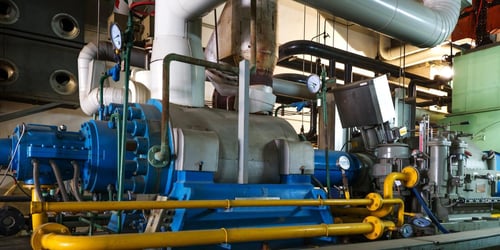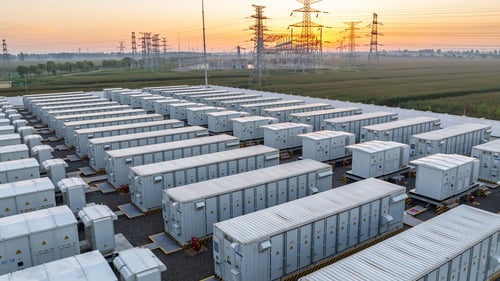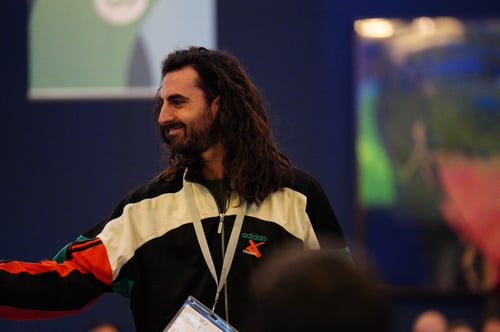Getting Europe’s Grids Fit for the 21st Century - Interview With SmartEn’s Executive Director Michael Villa
.jpg?width=768&name=Article%20Thumbnails%20-%201920x1080%20new%20website%20(34).jpg)
SmartEn is the European business association integrating the decentralised solutions of the clean energy transition to unleash the distributed flexibility potential of all consumers. With more than 100 member companies, smartEn represents a growing, dynamic business sector: the Flexible Demand Management Industry.
With over 15 years of experience in the energy industry, smartEn’s Executive Director Michael Villa is one of the leading authority voices in the European energy flexibility scene. We sat down with him to get his thoughts on what’s next for energy flexibility and how it will help build tomorrow’s European grid, the role of digitalisation, and what gives him hope we’ll realise the clean energy transition.
In this first part, we’re delving into making European grids fit for the challenges of today and tomorrow, and addressing tenacious misconceptions about flexibility.
Jump to:
- Making Europe's grids fit for the 21st century
- The role of flexibility in modern grids and the energy transition
- Opportunities created by energy flexibility for businesses
- Biggest misconceptions about flexibility
- What we need more of
The future of smart energy relies on strong and stable grids - how can we make Europe’s grids fit for the 21st century?
We must enable all consumers, individuals and companies alike, to play a key role in ensuring stable and reliable grids. Europe’s grids simply cannot be ready for the challenges of the 21st century without relying on the support that all connected consumers can provide.
Most importantly, we need system operators to change their mindset from a traditional, centralised system to a collaborative ecosystem where grids are made more reliable and resilient thanks to the active contribution of grid users.They need to invest in digitalisation and market-based platform to procure the flexibility of connected consumers.
If consumers with decentralised energy resources receive adequate signals and remunerations, they can flexibly adjust their energy consumption, storage of energy, and use renewables on-site.
By consumers, I mean all kinds of energy stakeholders: households, EVs, industries from SMEs to corporates, and even buildings. They all need to become more flexible by deploying new decentralised energy resources, and we need to be able to activate the flexibility of those resources.
What role does flexibility play in modernising grids and supporting the energy transition?
The smart electrification revolution will be the most cost-effective way to achieve European decarbonisation goals. It relies on the active contribution of electrified flexible users. If we only consider the electrification aspect – missing the smart part, such as changing building heating systems or switching to electric vehicles, we’ll only add pressure to the grid.
The grid cannot be reinforced simply by adding more cables or investing in copper. We do not have enough resources, financial and natural, to do so sustainably. That’s why we need grid-edge consumers with flexible equipment or assets to support the grid and mitigate these investments: they can contribute to a more efficient network operation and make grid operators more efficient.
Currently, TSOs and DSOs tend to only think about consumers as recipients and are stuck in this unidirectional modus operandi. This must change: the electrification of our energy system will be costly, and we need to find new ways, business models, mechanisms, and markets to make grid operation more efficient and redirect precious resourced where more cost-effective.
Some countries are proactive in this regard. The UK is a prime example of considering and engaging with active consumers, with the National Regulatory Authorities incentivising the use of consumers’ flexibility. We also saw positive developments in the Netherlands due to the country's high congestion risks, but recently we noticed alarming fallbacks.
Grid congestion, amplified by increased electrification, is another urgent challenge to address. These congestion risks can be tackled by the costly option of adding more lines to the grid, or with the cost-effective, smarter management of the existing network.
Which opportunities created by energy flexibility can businesses tap into?
The market-based activation of the distributed flexibility from decentralised energy resources is the fundamental revenue income from market players active in flexible demand management. Stacking this value from different markets they can bid into will strengthen their business model.
But it’s much more than the financial aspect. Businesses participating in flexibility services contribute to building a more reliable energy system and lessening the risk of blackouts. A strong, reliable grid benefits everyone, including businesses.
They also contribute to reducing CO2 emissions in energy systems. A more flexible grid enables the integration of renewable energy sources, mitigates renewable energy curtailment, and avoids relying on fossil fuel-generation power plants to balance the grid in times of need.
What are the biggest misconceptions people have about flexibility and the future of our energy systems?
I usually see three main misconceptions. The first is the idea that upgrading our energy systems will require behavioural changes with negative consequences. For example, industrials worry about not being able to meet their production deadlines because they’ll need to adjust their processes. We also see EV drivers, individuals and fleets alike, thinking they’ll be unable to use their vehicles during charging times. While it is true that we need to see behavioural and mindset changes, automation will solve these issues without negatively impacting comfort, well-being or industrial output.
The second misconception I see most often is a lack of trust in digital tools. Usually, it is either a worry about privacy risks or wondering if those digital tools actually work.
And finally, the third most common misconception concerns money. How much will I get for making my resources available? Whether we’re dealing with companies or individuals, there needs to be a solid return on investment for those tools, whether they provide savings or unlock additional revenue.
What do we need more of?
We primarily need a change of mindset by the leadership of System Operators, alongside a change in the remuneration model of TSOs and DSOs. TSOs and DSOs are regulated entities, with national regulatory authorities deciding on remuneration modalities. So far, DSOs have been financially incentivised to expand the grid by deploying more lines. If the remuneration model switched to one favouring grid flexibility and smarter management of the existing network, we could build a future-proof grid quicker and cheaper.
TSOs must also be open to demand-side resources to keep the system balanced, which is their primary responsibility. In the past, most of these balancing services were only open to generation plants, which were activated in times of need.
What crucially matters now is how fast we’ll be able to implement nationally the policy framework that has been decided at the EU level. Currently, out of the 64 legislative provisions that have been developed in the last seven years at EU level, only a few of them have been implemented at national level. The EU policy framework has tackled all the barriers and identified an enabling framework, so now it needs to be transposed.
Change is always difficult, which can explain why the national implementation of this legislation needs to catch up. There are many different stakeholders involved all along the value chain, from TSO and DSO to aggregators, suppliers, local trading platforms, and end consumers. All have different interests; few actually understand the intricacies of energy flexibility, and they all need to figure out how to interact to create this new system.
There is a strong need for better education of all stakeholders. System operators need to understand what business offer aggregators can provide them with and how to improve system planning in the short, medium, and long term. Energy suppliers need to realise they must offer flexible retail tariffs or become aggregators. Aggregators need to be able to provide their services to end consumers and energy markets, and end consumers need to understand they have this flexibility capability that can be monetised.
And crucially, we need more automation to facilitate the wide-scale deployment of flexibility across European energy systems.
To summarise, we need better education, faster national implementation of EU legislation, and increased automation. Central to achieving these changes are stronger business models.
Unlock New Revenue Streams with Demand Response
Check out our essential guide to energy flexibility.
_________
In the second part of this interview with Michael Villa, we’ll delve into the future of flexibility, how demand response and battery storage can work together, and the role of digitalisation.
Other articles you might find interesting
-
 Demand-side flexibility24 July 2024
Demand-side flexibility24 July 2024District Heating Operators: New Revenue From Grid Balancing
Read more -
 Demand-side flexibility24 July 2024
Demand-side flexibility24 July 2024Five Myths About Demand Response, Debunked!
Read more -
 Demand-side flexibility24 July 2024
Demand-side flexibility24 July 2024BESS & Demand Response, What’s the Connection?
Read more -
.jpg?length=500&name=Article%20Thumbnails%20-%201920x1080%20new%20website%20(4).jpg) Demand-side flexibility24 July 2024
Demand-side flexibility24 July 20243 Things to Look for in a Flexibility Service Provider
Read more -
.jpg?length=500&name=Article%20Thumbnails%20-%201920x1080%20new%20website%20(35).jpg) Demand-side flexibility24 July 2024
Demand-side flexibility24 July 2024smartEn Executive Director Michael Villa on the future of energy flexibility in Europe
Read more -
 Demand-side flexibility24 July 2024
Demand-side flexibility24 July 2024Empowering Industry through Energy Flexibility - Q&A with Raphaël Gras
Read more -
 demand response24 July 2024
demand response24 July 2024EU elections: Opportunity or Risk for Demand-Side Flexibility? - Q&A with Mathilde Chareyron
Read more -
 Energy management24 July 2024
Energy management24 July 2024Going From Passive to Active as an Energy Consumer - Q&A with Gianluca Rimini
Read more -
.jpg?length=500&name=Article%20Thumbnails%20-%201920x1080%20new%20website%20(5).jpg) Knowledge24 July 2024
Knowledge24 July 2024How to Earn Revenue with Demand Response
Read more -
.jpg?length=500&name=Article%20Thumbnails%20-%201920x1080%20new%20website%20(6).jpg) Demand-side flexibility24 July 2024
Demand-side flexibility24 July 2024Five Times Demand Response Saved the Grid
Read more